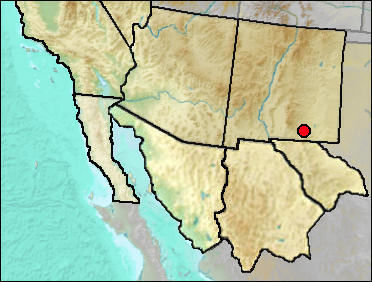 Age. Early Mid or Early Wisconsin. A
radiocarbon date on bone carbonates is 29,290 ± 1060, but likely is a minimum
date.
Age. Early Mid or Early Wisconsin. A
radiocarbon date on bone carbonates is 29,290 ± 1060, but likely is a minimum
date.
General Description. Lost Valley (UTEP Loc. 17) is a sink deep within Dry Cave; Above Lost Valley (UTEP Loc. 1) is a ledge above Lost Valley. A large fissure in the ceiling is now clogged, but is the obvious source of matrix and fossils for both, with some material spilling off of Loc. 1 into Loc. 17 proper. The fossils are treated as from a single site due to the common origin in space and, for the most part, in time.
Discussion. Extensive study of Sylvilagus specimens changes earlier conclusions somewhat. With the demonstration of overlap between Sylvilagus audubonii and S. floridanus (see Sylvilagus account), it is evident that one or the other is present, but it is unclear which. The identifications of S. nuttallii are moderately well supported, and its presence suggests that S. audubonii is the more likely candidate in view of the known co-occurrences. Among the woodrats, Neotoma leucodon and N. findleyi are present in approximately equal numbers, with N. pygmaea being represented by approximately five times as many specimens of either of those two; Neotoma micropus is rare. Cratogeomys outnumbers Thomomys bottae six to one. Microtus ochrogaster is the sole representative of the Arvicolinae. These and other faunal features led Harris (1987) to suggest that the Dry Cave climate at the time had winter temperatures milder than today, but that otherwise the climate was similar to that now found some 450 km to the north.
The unique occurrence of several taxa occurring in the Dry Cave early sites, such as Corvus neomexicanus, Neotoma pygmaea, and N. findleyi suggest an age unrepresented by other pre-pleniglacial sites within our region. Although the age suggested is mid or early Wisconsin, an earlier date cannot be ruled out. On the other hand, judging on available faunas, pre-full glacial climates of sites east of the Guadalupe Mountains appear to have been significantly different from those to the west, and it is not clear whether such climatic differences were contemporaneous or a result of temporal differences between the faunas (Harris 1987).
Fauna.
Osteichthyes
Osteichthyes—Bony Fish (Harris 1993c)
Amphibia
Anaxyrus sp.—Nearctic Toads (UTEP)
Reptilia
Cophosaurus texanus—Greater Earless Lizard (Harris 1993c: ? gen. et
sp.)
Crotaphytus collaris—Eastern Collared Lizard (Harris 1993c)
Phrynosoma cornutum—Texas Horned Lizard (Harris 1993c)
Phrynosoma hernandesi—Mountain Short-horned Lizard (Harris 1993c)
Phrynosoma modestum—Round-tailed Horned Lizard (Harris 1993c)
Sceloporus (small)—Spiny Lizard (small) (Harris 1993c)
Coluber/Masticophis—Racer/Coachwhip (UTEP)
Pituophis catenifer—Gopher Snake (UTEP)
Crotalus sp.—Rattlesnakes (UTEP)
Aves
†Breagyps clarkii—Clark's Condor (Harris 1993c)
†Coragyps occidentalis—Western Vulture (Harris 1993c)
Aquila chrysaetos—Golden Eagle (Harris 1993c: cf.)
Zenaida macroura—Mourning Dove (Harris 1993c: cf.)
Bubo virginianus—Great Horned Owl (Harris 1993c)
Colaptes auratus—Northern Flicker (UTEP)
Aphelocoma sp.—Shrub Jays (UTEP: ?)
Corvus corax—Common Raven (Harris 1993c)
†Corvus neomexicanus—New Mexican Raven (Magish and Harris
1976)
Cyanocitta sp.—Blue Jays (Harris 1993c: ?)
Mammalia
Ammospermophilus sp.—Antelope Squirrel (Harris 1993c)
Cynomys mexicanus—Mexican Prairie Dog (Goodwin 1995: cf.)
Ictidomys tridecemlineatus—Thirteen-lined Ground Squirrel (UTEP)
Tamias sp.—Chipmunk (Harris 1993c)
Dipodomys ordii—Ord's Kangaroo Rat (Harris 1993c)
Dipodomys spectabilis—Banner-tailed Kangaroo Rat (Harris 1993c)
Perognathus sp.—Silky Pocket Mouse (Harris 1993c)
Cratogeomys castanops—Yellow-faced Pocket Gopher (Harris 1993c)
Thomomys bottae—Botta's Pocket Gopher (Harris 1993c)
Microtus ochrogaster—Prairie Vole (Harris 1985)
†Neotoma findleyi—Findley's Woodrat (Harris 1984d)
Neotoma leucodon—White-toothed Woodrat (Harris 1985)
Neotoma micropus—Southern Plains Woodrat (Harris 1985)
†Neotoma pygmaea—Pygmy Woodrat (Harris 1984d)
Onychomys leucogaster—Northern Grasshopper Mouse (UTEP: cf.)
Peromyscus boylii—Brush Mouse (Harris 1993c) Identification Withdrawn
Sigmodon sp.—Cotton Rat (Harris 1993c)
†Aztlanolagus agilis—Aztlán Rabbit (Russell and Harris
1986)
Lepus californicus—Black-tailed Jackrabbit (Harris 1993c)
Sylvilagus audubonii—Desert Eastern Cottontail (UTEP: ?)
Sylvilagus floridanus—Eastern Cottontail (UTEP: cf.)
Sylvilagus nuttallii—Mountain Cottontail (Harris 1993c)
Sorex merriami—Merriam's Shrew (Harris 1993c)
Nyctinomops macrotis—Big Free-tailed Bat (Harris 1993c; WITHDRAWN: voucher
not found)
Tadarida brasiliensis—Mexican Free-tailed Bat (Harris 1993c: cf.)
Antrozous pallidus—Pallid Bat (Harris 1993c)
Corynorhinus sp.—Big-eared Bat (Harris 1993c; UTEP: cf.)
Myotis velifer—Cave Myotis (Harris 1993c)
Lynx rufus—Bobcat (Harris 1993c)
Puma concolor—Mountain Lion (Harris 1993c: cf.)
Canis latrans—Coyote (Harris 1993c)
Urocyon cinereoargenteus—Gray Fox (Harris 1993c)
†Brachyprotoma sp.—Short-faced Skunk (UTEP: ?)
Spilogale—Spotted Skunk (Harris 1993c)
Tapirus merriami—Merriam's Tapir (Harris 1985)
Tapirussp.
Equus sp.—Horse (Harris 1985)
Camelops hesternus—Yesterday's Camel (Harris 1993c: cf.)
Antilocapra americana—Pronghorn (Harris 1993c)
Capromeryx sp.—Miniature Pronghorn (Harris 1985)
Stockoceros conklingi—Conkling's Pronghorn (UTEP)
Odocoileus sp.—Deer (UTEP)
Literature. Goodwin 1995; Harris 1984d, 1985a, 1987, 1993c; Harris and Porter 1980; Magish and Harris 1976.
Last Update: 25 Nov 2014